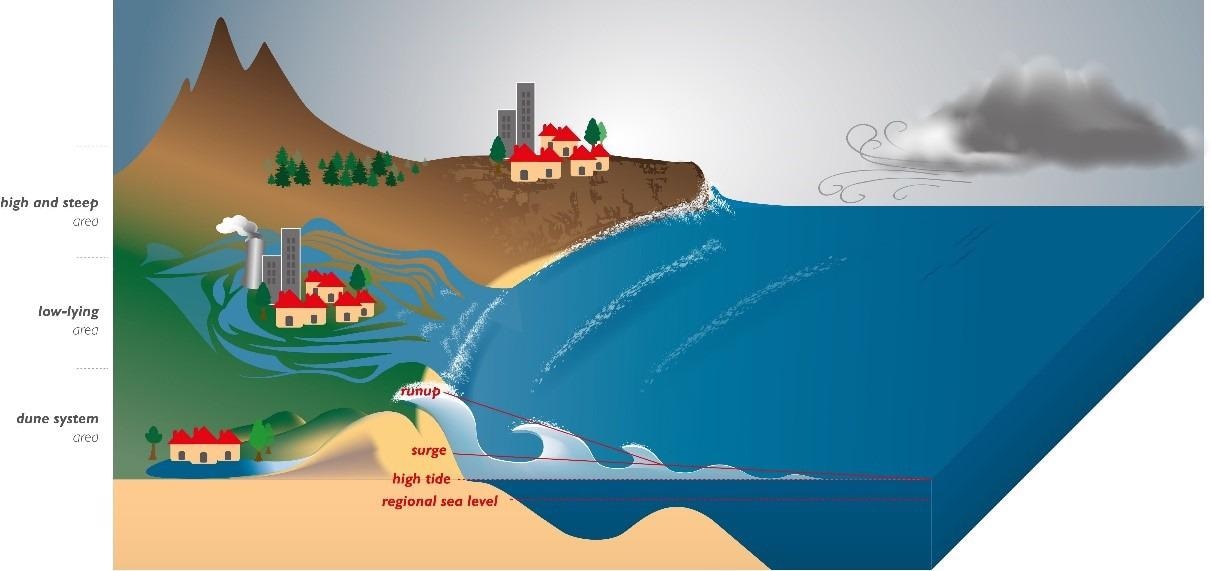Jun 21 2021
In the last few decades, sea-level rise combined with waves, tides and storm surges has increased the overtopping of artificial and natural coastal protection by almost 50%. The finding was revealed by an international study coordinated by the Institut de Recherche pour le Développement (IRD), involving global partners.
 Diagram explaining the phenomenon of marine submersion. Image Credit: Rafaël Almar et al., Nature Communication.
Diagram explaining the phenomenon of marine submersion. Image Credit: Rafaël Almar et al., Nature Communication.
The study has been published in the Nature Communications journal.
By integrating digital models and satellite data, the researchers have revealed that coastal overtopping, and thus the risk of flooding, is expected to accelerate over the 21st century, by up to 50 times under a high emission global warming situation, particularly in the tropics. This surge is mainly caused by a combination of ocean waves and sea-level rise.
Low-lying coastal areas host almost 10% of the global population. Apart from the rising sea-level and ongoing erosions, these regions and their unique ecosystems are experiencing destructive hazards, such as extreme flooding caused by the overtopping of artificial/natural protection. This is similar to the case of Typhoon Haiyan that occurred in Asia in 2013 (the largest tropical cyclone to be ever measured) and Cyclone Xynthia that took place in Europe in 2010.
Such episodic events are predicted to become more frequent and more severe because of global warming, while the consequence will also increase because of increased anthropogenic pressures, like rapid urbanization and coastal and infrastructure development. Even though the frequency and magnitude of such events continue to be vague, scientists believe that countries in the tropical regions would be specifically affected.
In spite of the major role played by ocean waves in establishing the coastal sea-levels, their contribution to coastal flooding has been largely ignored in the past, mainly due to a dearth of precise coastal topographical data.
Measuring Past Events to Estimate Future Risks
In the latest study, French scientists from IRD, CNES and Mercator Ocean, along with colleagues from Brazil, Portugal, Italy, Dutch and Nigeria, integrated an unparalleled global digital model for surface elevations with new predictions of the extreme sea-levels. Such extreme water levels comprise tides, existing measurements of artificial and natural coastal defenses and analysis of wind-driven waves.
The research was initiated by measuring the rise in global submersion events that took place from 1993 to 2015. To achieve this, two key parameters for coastal topography were defined using satellite data. One parameter is the maximum subaerial elevation of the coasts and the other is the local beach slope. The extreme coastal water level was measured in hourly timesteps indeed to identify the potential annual number of hours during which coastal defenses could be overtopped in every region.
The combination of tides and episodes of large waves is the main contributor to episodes of coastal overflow. We identified hot-spots, where the increase in risks of overtopping is higher, such as in the Gulf of Mexico, the Southern Mediterranean, West Africa, Madagascar and the Baltic Sea.
Rafael Almar, Researcher in Coastal Dynamics, IRD
Acceleration During the 21st Century
By considering various sea-level rise scenarios, the researchers also conducted a preliminary global assessment of the possible coastal overtopping over the 21st century. The results revealed that the number of overtopping hours may increase with a faster speed than the average speed of sea-level rise.
The frequency of overtopping is accelerating exponentially and will be clearly perceptible as early as 2050, regardless of the climate scenario. By the end of the century, the intensity of the acceleration will depend on the future trajectories of greenhouse gas emissions and therefore the rise in sea-level.
Rafael Almar, Researcher in Coastal Dynamics, IRD
“In the case of a high emissions scenario, the number of overtopping hours globally could increase fifty-fold compared with current levels. As we go along the 21st century, more and more regions will be exposed to overtopping and consequent coastal flooding, especially in the tropics, north-western United States, Scandinavia, and the Far East of Russia,” Almar concluded.
Additional studies will be required on regional and local levels to elaborate these global projections, which offer a strong basis for recommending effective adaptation measures in the detected hotspots.
Journal Reference:
Almar, R., et al. (2021) A global analysis of extreme coastal water levels with implications for potential coastal overtopping. Nature Communications. doi.org/10.1038/s41467-021-24008-9.